
Concept explainers
(a)
Interpretation:
For the given molecule, the complete IUPAC name is to be written.
Concept introduction:
To write the IUPAC name, first, it is important to determine the highest-priority functional group present that requires a suffix referring to Table E-1. For the molecules having two or more highest-priority
The main chain or ring containing the highest-priority functional group is to be determined. The next step is to number the main chain or ring such that carbon atoms involving highest-priority functional group receive the lowest possible numbers. The locator number for the highest-priority functional group is written immediately before the suffix unless needed. All other functional groups in the molecule are treated as substituents and appear in the name as a prefix. Prefixes such as ‘di’, ‘tri’, ‘tetra’... etc. are used to indicate the number of identical substituents attached. The substituents are named in alphabetical order.
In the IUPAC name of the molecule, the stereochemical configurations at the chiral centers are included as R/S. When assigning priorities to substituents, the atom having the greater
When the fourth priority substituent is pointing away (it is attached by a dash bond) and the first, second, and third priority substituents are arranged clockwise, the configuration is R.
When the fourth priority substituent is pointing away (it is attached by a dash bond) and the first, second, and third priority substituents are arranged counterclockwise, the configuration is S.
If the fourth priority substituent is attached by a wedge bond, then the clockwise or counterclockwise arrangement of the first, second, and third priority substituents is determined and that arrangement is reversed before assigning R or S.
If the fourth priority substituent is in the plane of the page, then it is switched with the substituent that points away. Then, the clockwise or counterclockwise arrangement of the first, second, and third priority substituents is determined, and that arrangement is reversed before assigning R or S.
When writing the IUPAC name, the R or S designation is written in parenthesis for each asymmetric carbon atom and hyphens are used to separate those designations from the rest of the IUPAC name.
Answer to Problem E.32P
The complete IUPAC name for the given molecule, considering the given stereochemistry, is
Explanation of Solution
The given molecule is:
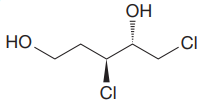
The molecule above contains two
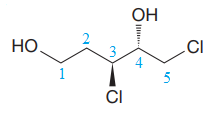
The corresponding locator numbers are also added before the prefix ‘di’. Thus, the name of the root is
There are two chiral centers in the given molecule at C3 and C4 carbon atoms.
The C3 carbon attached to Chlorine atom by a wedge bond has the S configuration, while the C4 carbon attached to the
The complete IUPAC name for the given molecule considering the given stereochemistry
is written above.
(b)
Interpretation:
For the given molecule, the complete IUPAC name is to be written.
Concept introduction:
To write the IUPAC name, first, it is important to determine the highest-priority functional group present that requires a suffix referring to Table E-1. For the molecules having two or more highest-priority functional groups, the rules are slightly different. In the IUPAC name of such molecules, the final ‘e’ of ‘ane’, ‘ene’, or ‘yne’ is not removed in the suffix. Prefixes such as ‘di’, ‘tri, etc are written immediately before the suffix to specify the number of highest-priority functional groups. Add a locator number for each of the highest-priority functional groups immediately before the prefixes.
The main chain or ring containing the highest-priority functional group is to be determined. The next step is to number the main chain or ring such that carbon atoms involving the highest-priority functional group receive the lowest possible numbers. The locator number for the highest-priority functional group is written immediately before the suffix unless needed. All other functional groups in the molecule are treated as substituents and appear in the name as a prefix. Prefixes such as ‘di’, ‘tri’, ‘tetra’… etc. are used to indicate the number of identical substituents attached. The substituents are named in alphabetical order.
In the IUPAC name of the molecule, the stereochemical configurations at the chiral centers are included as R/S. When assigning priorities to substituents, the atom having the greater atomic number has higher priority.
When the fourth priority substituent is pointing away (it is attached by a dash bond) and the first, second, and third priority substituents are arranged clockwise, the configuration is R.
When the fourth priority substituent is pointing away (it is attached by a dash bond) and the first, second, and third priority substituents are arranged counterclockwise, the configuration is S.
If the fourth priority substituent is attached by a wedge bond, then the clockwise or counterclockwise arrangement of the first, second, and third priority substituents is determined and that arrangement is reversed before assigning R or S.
If the fourth priority substituent is in the plane of the page, then it is switched with the substituent that points away. Then, the clockwise or counterclockwise arrangement of the first, second, and third priority substituents is determined and that arrangement is reversed before assigning R or S.
When writing the IUPAC name, the R or S designation is written in parenthesis for each asymmetric carbon atom, and hyphens are used to separate those designations from the rest of the IUPAC name.
Answer to Problem E.32P
The complete IUPAC name for the given molecule is
Explanation of Solution
The given molecule is:
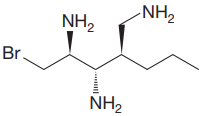
The molecule above contains three
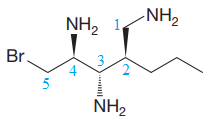
The corresponding locator numbers are also added before the prefix ‘tri’. Thus, the name of the root is
The carbon atoms C2 and C3 have two substituents attached.
One propyl group is attached to the C2 carbon atom of the root, while one bromine atom is attached to the C5 carbon atom of the root. The substituents are named in alphabetical order.
Thus, the complete IUPAC name for the compound without considering the stereochemistry is
There are three chiral centers in the given molecule.
The C2 carbon atom has R configuration.
The C3 carbon attached to
The C4 carbon attached to
Thus, the IUPAC name of the compound, considering the given stereochemistry is,
The complete IUPAC name for the given molecule considering the given stereochemistry
is written above.
(c)
Interpretation:
For the given molecule, the complete IUPAC name is to be written.
Concept introduction:
To write the IUPAC name, first, it is important to determine the highest-priority functional group present that requires a suffix referring to Table E-1. For the molecules having two or more highest-priority functional groups, the rules are slightly different. In the IUPAC name of such molecules, the final ‘e’ of ‘ane’, ‘ene’, or ‘yne’ is not removed in the suffix. Prefixes such as ‘di’, ‘tri, etc are written immediately before the suffix to specify the number of highest-priority functional groups. Add a locator number for each of the highest-priority functional groups immediately before the prefixes.
The main chain or ring is to be determined to be the one that contains the highest-priority functional groups. The next step is to number the main chain or ring such that carbon atoms involving highest-priority functional group receives the lowest possible numbers. The locator number for the highest-priority functional group is written immediately before the suffix unless needed. All other functional groups in the molecule are treated as substituents and appear in the name as a prefix. Prefixes such as ‘di’, ‘tri’, ‘tetra’… etc. are used to indicate the number of identical substituents attached. The substituents are named in alphabetical order.
In the IUPAC name of the molecule, the stereochemical configurations at the chiral centers are included as R/S. When assigning priorities to substituents, the atom having the greater atomic number has higher priority.
When the fourth priority substituent is pointing away (it is attached by a dash bond) and the first, second, and third priority substituents are arranged clockwise, the configuration is R.
When the fourth priority substituent is pointing away (it is attached by a dash bond) and the first, second, and third priority substituents are arranged counterclockwise, the configuration is S.
If the fourth priority substituent is attached by a wedge bond, then the clockwise or counterclockwise arrangement of the first, second, and third priority substituents is determined and that arrangement is reversed before assigning R or S.
If the fourth priority substituent is in the plane of the page, then it is switched with the substituent that points away. Then, the clockwise or counterclockwise arrangement of the first, second, and third priority substituents is determined and that arrangement is reversed before assigning R or S.
When writing the IUPAC name, the R or S designation is written in parenthesis for each asymmetric carbon atom and hyphens are used to separate those designations from the rest of the IUPAC name.
Answer to Problem E.32P
The complete IUPAC name for the given molecule is
Explanation of Solution
The given molecule is:
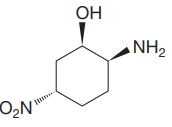
The molecule above contains one
The numbering is shown below:
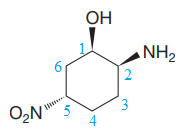
The name of the root is
There is one
Thus, the complete IUPAC name without considering the stereochemistry for the compound is
There are three chiral centers in the molecule.
The C1 carbon atom attached to the
The C2 carbon attached to the
The C5 carbon attached to the
Thus, the IUPAC name of the compound considering the given stereochemistry is
The complete IUPAC name for the given molecule considering the given stereochemistry
is written above.
Want to see more full solutions like this?
Chapter E Solutions
ORGANIC CHEMISTRY PRINCIPLES & MECHANISM
- Draw product A, indicating what type of reaction occurs. NH2 F3C CF3 NH OMe NH2-NH2, ACOH Aarrow_forwardPhotochemical smog is formed in part by the action of light on nitrogen dioxide. The wavelength of radiation absorbed by NO2 in this reaction is 197 nm.(a) Draw the Lewis structure of NO2 and sketch its π molecular orbitals.(b) When 1.56 mJ of energy is absorbed by 3.0 L of air at 20 °C and 0.91 atm, all the NO2 molecules in this sample dissociate by the reaction shown. Assume that each absorbed photon leads to the dissociation (into NO and O) of one NO2 molecule. What is the proportion, in parts per million, of NO2 molecules in this sample? Assume that the sample behaves ideally.arrow_forwardCorrect each molecule in the drawing area below so that it has the skeletal ("line") structure it would have if it were dissolved in a 0.1 M aqueous solution of HCI. If there are no changes to be made, check the No changes box under the drawing area. No changes. HO Explanation Check NH, 2 W O :□ G ©2025 M unter Accessibilityarrow_forward
- An expression for the root mean square velocity, vrms, of a gas was derived. Using Maxwell’s velocity distribution, one can also calculate the mean velocity and the most probable velocity (mp) of a collection of molecules. The equations used for these two quantities are vmean=(8RT/πM)1/2 and vmp=(2RT/M)1/2 These values have a fixed relationship to each other.(a) Arrange these three quantities in order of increasing magnitude.(b) Show that the relative magnitudes are independent of the molar mass of the gas.(c) Use the smallest velocity as a reference for establishing the order of magnitude and determine the relationship between the larger and smaller values.arrow_forwardThe reaction of solid dimethylhydrazine, (CH3)2N2H2, and liquefied dinitrogen tetroxide, N2O4, has been investigated for use as rocket fuel. The reaction produces the gases carbon dioxide (CO2), nitrogen (N2), and water vapor (H2O), which are ejected in the exhaust gases. In a controlled experiment, solid dimethylhydrazine was reacted with excess dinitrogen tetroxide, and the gases were collected in a closed balloon until a pressure of 2.50 atm and a temperature of 400.0 K were reached.(a) What are the partial pressures of CO2, N2, and H2O?(b) When the CO2 is removed by chemical reaction, what are the partial pressures of the remaining gases?arrow_forwardOne liter of chlorine gas at 1 atm and 298 K reacts completely with 1.00 L of nitrogen gas and 2.00 L of oxygen gas at the same temperature and pressure. A single gaseous product is formed, which fills a 2.00 L flask at 1.00 atm and 298 K. Use this information to determine the following characteristics of the product:(a) its empirical formula;(b) its molecular formula;(c) the most favorable Lewis formula based on formal charge arguments (the central atom is N);(d) the shape of the molecule.arrow_forward
- How does the square root mean square velocity of gas molecules vary with temperature? Illustrate this relationship by plotting the square root mean square velocity of N2 molecules as a function of temperature from T=100 K to T=300 K.arrow_forwardDraw product B, indicating what type of reaction occurs. F3C CF3 NH2 Me O .N. + B OMearrow_forwardBenzimidazole E. State its formula. sState the differences in the formula with other benzimidazoles.arrow_forward
- Draw product A, indicating what type of reaction occurs. F3C CN CF3 K2CO3, DMSO, H₂O2 Aarrow_forward19) Which metal is most commonly used in galvanization to protect steel structures from oxidation? Lead a. b. Tin C. Nickel d. Zinc 20) The following molecule is an example of a: R₁ R2- -N-R3 a. Secondary amine b. Secondary amide c. Tertiary amine d. Tertiary amidearrow_forwardpls helparrow_forward

 Chemistry for Today: General, Organic, and Bioche...ChemistryISBN:9781305960060Author:Spencer L. Seager, Michael R. Slabaugh, Maren S. HansenPublisher:Cengage Learning
Chemistry for Today: General, Organic, and Bioche...ChemistryISBN:9781305960060Author:Spencer L. Seager, Michael R. Slabaugh, Maren S. HansenPublisher:Cengage Learning

